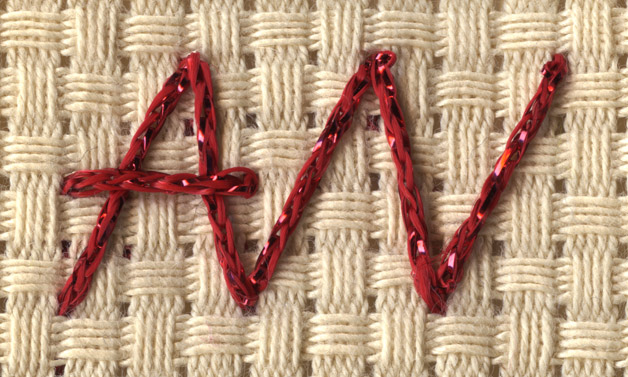A small cat is toying with a granade, a space ship touches down in a green forest and a Mona Lisa is wearing a headset. For her work, Agnes Nuber is recycling half cross stritch tapestry by introducing modern pop cultural symbols and elements into the original design to comment on its context and meanings.
The original tapestries which form the basis for Nuber’s work were carefully hand stitched in the 1960s and 1970s and are now sold through flea markets and household clearings. Depending on the design and its frame, some works are worth more than a thousand euros. Still, most of them were created in a paint by numbers style for private means. Usually presented in an oak frame, they have decorated German living rooms for decades. „Every work has its own story. There are always surprises with them. You can regularly find notes, names or prices in the frame or the cover panels. I feel a great amount of respect for the stitchers, who have spent long hours working on it. Each one also carries a memory and reference to the wall and the place where its has hung for years until there was no-one left to appreciate it anymore“ reports Nuber about the dying craft.
This type of tapestry, whose German name Gobelin refers to the French manifactory, is characterised by the technique of using a thin thread to cross stitch diagonally across the lease. Nuber carefully loosens the original stitching to make room for the new elements within the design and returns the images to its original frame in the end.
Therefore, each work refers its bourgeois origins, to a time when panoramic mountain landscapes, stale still lifes and christian icons dominated German interior designs. Nuber appropriates these images and literally interweaves them with modern and pop cultural symbols. Tower blocks overshadow peaceful forests, a madonna dreamily listens to unknown music through large headphones and a lonely astronaut wanders across green meadows as if he was on an alien planet. This juxtaposition of elements in the vein of mashup art and cultural jamming allows a reevaluation of the „German Spießigkeit“, exposes an era’s dreams and desires and creates new layers of meaning, which at times may be irritating and surprising, but always joyful and diverse.
Text 4/2013: Lili Hartwig/Tim Gallwitz

